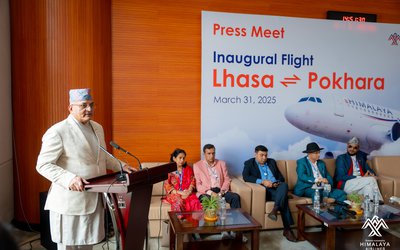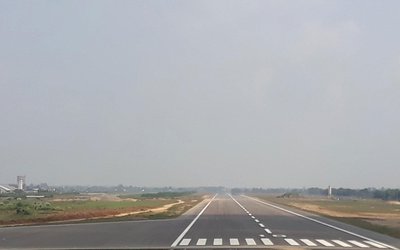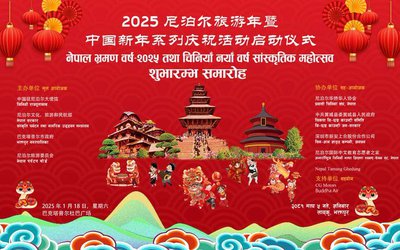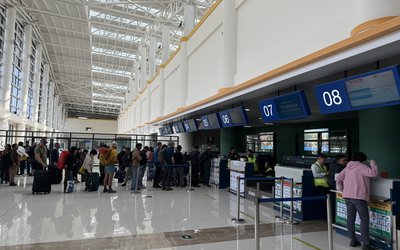
Nepal is celebrating the Tourism Year 2013 by organizing various programs aimed at luring more tourists. Once again, however, a major political transition, fraught with risks of political confrontations and chaos before the second Constituent Assembly election in November, is reigning over the prospects of tourism growth. There are some good signs as well, though. After nearly two ad-hoc years, Nepal Tourism Board, the main body responsible to market Nepal globally, has got Subhas Niraula as the acting chief executive officer who has the full authority to implement the new initiatives as announced by the government.
There are several exquisite tourism products in Nepal. The diversity in culture, nature and ethnicity makes it a destination par excellence. Within a short distance, one who is spellbound to find the highest points of the world will also see the lowest points. There is the tuna climate. There is the warm climate. Along with this, Nepal’s advantage is that it has well established tourism destinations and human resources.
Nepal has enormous potentials to sell its products in the international tourism market. However, long and frequent political instability, frequent changes of government and its inconsistent policies have overshadowed the best of possibilities. At a time when the global warming is gradually affecting the climatic order, countries like Nepal need to take an additional care. This year’s slogan for the Tourism Year has reminded us as to how countries like Nepal need to preserve water, along with promoting tourism.
Conservation of water is essential for the survival of culture, life and ecology and natural beauty of the Himalayas. As trekking, mountaineering and rafting are the products, directly linked with the conservation of water, the slogan of WTD 2013 had a greater importance.
The government of Nepal has already expressed its commitment to preserve water. However, the current problem for Nepal is to increase air accessibility, end political uncertainty and explore new venues and destinations as well as infrastructure to replace the over-saturated tourist spots
Given the current political trend with the CA elections on November 19, it is likely to increase confrontations between political forces. It will result in a deteriorating internal situation, which is likely to affect the tourism sector in the remaining three months of year 2013.
“The strikes called by political parties is likely to damage tourism prospects. Such activities will discourage the travellers from visiting our country, which in turn will dent the country’s image,” said Sushil chimire, secretary of the Ministry of Culture, Tourism and Civil Aviation. He added that many challenges lay ahead for the country’s tourism.
“The government is serious about the issue such as the decline in the length of stay and spending of tourists,” Ghimire said, adding that the private sector and other stakeholders should now market Nepal in a different way.
At a time when Nepal’s tourism sector is facing a decline recently after making subsequent improvements in the number of tourist arrival for a while, the forthcoming elections are likely to affect the tourists arrival.
“There are ways to improve the situation. Given the current political situation, Nepal is likely to see a more unstable period in the coming days. However, we have to find out ways to maintain the momentum. I am optimistic that the political leadership will understand the situation,” said Acting Chief Executive Officer of Nepal Tourism Board Subhas Niroula. “We are committed to move forward for the betterment of tourism industry. Nepal Tourism Board Management will put its focus on effective promotion of tourism and products and services in both domestic and international arena,” said Niroula, speaking at a program to mark the world tourism day.
After nearly two years of ad-hoc system, Niroula has been recently promoted as an acting CEO with full authority to run the NTB. This in itself is a good indication for Nepal’s tourism sector which needs to implement many drastic marketing exercises to lure Nepal bound tourists.
WTD 2013
As this year’s slogan is “Tourism and Water – Protecting Our Common Future, it has great importance for Nepal. Since Nepal is gradually becoming a popular destination for rafting, protecting the water is of prime importance for Nepal.
“The government is doing internal homework to dedicate certain river segments for adventure tourism activities,” said Mohan Krishna Sapkota, joint secretary at the Ministry of Culture, Tourism and Civil Aviation (MoCTCA) speaking at a program organized by Nepal Tourism Board (NTB) to mark 34th World Tourism Day.
Nepal marked the 34th International Tourism Day by organizing different programs throughout the country. The day is marked every year on September 27 at the call of the United Nations World Tourism Organization (UNWTO).
A cultural procession was organised jointly by 40 tourism organisations to increase public awareness about the importance of tourism as part of the celebrations of WTD. The rally started from Thamel and concluded at Basantapur after going through Durbar Marg, Ratna Park and New Road.
Nepal tourism entrepreneurs are demanding certain section of the river be set aside purely for rafting. A few days ago, Nepal Association of Rafting Agents (NARA) had proposed to the government to dedicate Baireni-Muglin section of Trishuli River for water activities.
“We are very happy that the government is formally making announcement to this effect very soon,” Thapa said, adding that the government will dedicate some sections of Bhotekoshi, Sunkoshi and Karnali rivers for water activities like rafting.
New Packages
Unlike in the past, the organizers announced certain actions. Minister for Agricultural Development Tek Bahadur Thapa, who is also looking after the tourism portfolio, and tourism secretary Sushil Ghimire inaugurated a Trekkers Information Management System (TIMS) Counter and newly structured Help Desk and Information Centre built in NTB premises.
Similarly, minister Thapa also launched the ´Great Buddhist Trail´ identified by Buddhistcircuits.com. He also unveiled publications like ´Nepal Tourism Year 2011´ and the souvenir ´Gorkha Tourism´. Similarly, NTB appointed Chimmi Sherpa, first Miss Sherpa 2012 and Min Bahadur Serchan - the eldest Nepali to climb Mt Everest - as the goodwill ambassadors of Nepali tourism industry. NTB also provided a certificate of appreciation and cash prize of Rs 10,000 to its security guard Tulsi Pokharel.
On the occasion, the Village Tourism Promotion Forum (VITOF) Nepal announced Chitlang village in Makwanput district as ´Village Tourism Destination 2013/14´.
“Despite many ups and downs, Nepal has made a certain progress in the tourism sector. The time is now to focus on increasing the tourist spending by introducing innovative tourism products,” said secretary Ghimire, speaking on the occasion. “Our national flag carrier is not being able to support tourism industry because of aircraft shortage,” he said, adding, “But the good thing is that we have already placed orders to buy two aircraft from China.” He also said the government aims to complete upgradation of Gautam Gautam Buddha Airport in Bhairahawa to a regional airport by June, 2017.
“Nepal needs to focus on agro tourism and eco tourism for the sustainable development of the tourism industry,” Ramesh Dhamala, president of Trekking Agencies´ Association of Nepal (TAAN), said. He also asked the government to do the needful in controlling illegal operation in tourism business.
“Instead of expressing worries for the declining number of tourists, Nepal needs to take some drastic steps to improve the infrastructure,” said Pabitra Kumar Karki, president of Nepal Association of Travel Agents (NATA).
However, nothing remarkable has been done in the last two years. After a successful tourism marketing in 2011, the government and private sector both failed to work together. The result is the declining tourists arrival in the last two months. As the elections approach and political instability intensifies, this is going to be a more difficult year for Nepal in terms of luring the tourists. Nepal, in other words, is yet to create conducive environment for tourist to visit Nepal.
There is the need to improve the law and order situation, upgrade airport’s facilities and add other infrastructure in new destinations. President of Trekking Agents Association Ramesh Dhamala argues that there is a lack of enough infrastructure. It is sad that the government’s lackluster performance is responsible for the lack of infrastructure.
In 2012, tourism contributed 9.4% to Nepal’s gross domestic product (GDP) in total, and direct earnings from foreign tourists have grown at an average of 12.4% over the past 10 years. It is estimated that the sector supported 1.2 million jobs, and has provided a steady and comparatively good income for a large number of Nepalis, including reasonable incomes for poorer people.
Nepal has unique assets for tourism development, and a great diversity of products; key attractions include trekking and adventure activities, religious and cultural sites and nature tourism. The country has an established niche in international tourism, with tourist arrivals exhibiting strong and stable growth, and growth and opportunities from neighbouring markets as well as a stable contribution from traditional source markets.
There are, however, some worrying trends that could threaten the chances for developing tourism as a central pillar of an inclusive economy. Value captured per tourist has declined sharply, low-end businesses have mushroomed and signs of overcrowding suggest the sector is on course for a ‘low-value, high-volume’ model that will not be sustainable. Major challenges for the development of the sector include broad systemic problems such as poor infrastructure, political instability, human resource constraints, economic governance issues, a poor investment environment and a lack of government leadership. But three problems are identified as the most urgent and pressing issues for the sector.
As the highlight of WTD 2013, a high-level Think Tank on Tourism and Water gathered leading experts on water preservation, public and private sector tourism stakeholders and media experts to discuss key issues contributing to a more sustainable water future.
With over one billion people traveling the world every year, the tourism sector can play an educational role as a water-conscious sector. Though tourism only uses 1% of global water consumption, challenges remain for water use at destinations, since the sector often competes with other sectors for water.
There is significant room for increasing efficiency and reducing cost of water consumption in hotels (water accounts for 10% of utility bills in many hotels, most of which pay for the water they consume twice, first in buying fresh water and by disposing of it as wastewater).
Investing in green technology is economically beneficial, with profits from water sanitation and wastewater treatment having a return on investment (ROI) of one to three years.
Given tourism´s size and reach, the sector is well-positioned to make a real contribution to preserving the world´s precious water resources.
Although there are many challenges ahead including the immediate challenge of political instability, there is a way out to improve the situation. After a long gap, Nepal Tourism Board has got the acting CEO with functional role, Nepal Airlines is to buy new aircraft and the government decision is to open new destinations, there are better hopes for tourism promotion in Nepal.

Debesh Adhikari
Adhikari is a computer science student and writes on various contemporary issues.
- The UK Expressed Deep Concerned About Tensions in Nepal
- Mar 09, 2017
- Development Partners and Ministry of Education Agree to drive quality education
- Sep 28, 2016
- END HUNGERNepal plans to end hunger by 2025
- Mar 14, 2016
- UK Hopes For Inclusive Resolution For Nepal
- Sep 17, 2015
- Micromax Launches Bolt D320 For Nepali Market
- Aug 07, 2015















